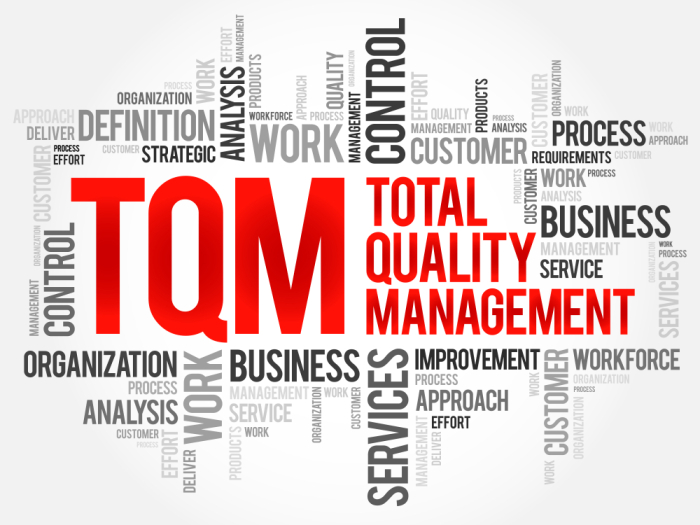
 Data Structure
Data Structure Networking
Networking RDBMS
RDBMS Operating System
Operating System Java
Java MS Excel
MS Excel iOS
iOS HTML
HTML CSS
CSS Android
Android Python
Python C Programming
C Programming C++
C++ C#
C# MongoDB
MongoDB MySQL
MySQL Javascript
Javascript PHP
PHP
- Selected Reading
- UPSC IAS Exams Notes
- Developer's Best Practices
- Questions and Answers
- Effective Resume Writing
- HR Interview Questions
- Computer Glossary
- Who is Who
Factors of Total Quality Management in Service Sectors
Many service industries are turning to TQM in today's fiercely competitive business environment as a means of preserving their competitive edge. We shall examine the various elements that contribute to TQM's success in the service industry in this post. Additionally, we'll look at some of the top techniques created to make TQM successful in the service industry.

TQM and Service Sector
Total Quality Management (TQM), a holistic approach to quality management, encourages businesses to pursue excellence across the board. It includes the full spectrum of tasks, from preparation and design to creation, service provision, and client satisfaction.
TQM focuses on customer happiness, process improvement, cost cutting, and enhanced efficiency to improve the quality of products and services in service industries. The strategy considers all parties involved, including partners, suppliers, customers, and other stakeholders. TQM promotes continual process and performance improvement by making sure that everyone in the organization collaborates to achieve excellence.
Theoretical Model of TQM
TQM implements quality management principles across the entire organization, including all divisions and personnel. TQM is founded on a set of values intended to establish and uphold excellence across a business. These values include staff involvement, process control, continuous improvement, and customer emphasis. The success of every service industry depends on each of the following factors &miuns;
Customer Focus ? Businesses must put the requirements of the customer first by identifying those needs and implementing processes to address them. Customers must be informed of how well their procedures are working, and improvements must be made as necessary.
Ongoing Improvement ? To be competitive, organizations must continuously assess and enhance their procedures. This includes monitoring performance and altering procedures as needed.
Process Control ? Businesses need to monitor their processes to make sure they adhere to best practices and satisfy client requirements. This entails standard-setting, performance evaluation, and process and procedure documentation.
Employee Involvement ? For the process to be successful, employees must be involved. This entails delivering quality management training, promoting candid communication between staff and management, and putting in place quality assurance procedures.
If properly applied, TQM can be a potent instrument for enhancing operations in the service sector. Organizations can develop a culture of quality that will guarantee success by concentrating on customer needs, continuously improving processes, managing processes, and involving people.
Factors of TQM in A Service Sector
TQM can be used in any company or sector, but it is crucial in the service sector because of how much customers depend on the caliber of the services they receive. Businesses including restaurants, hotels, banks, retail stores, and transportation providers are all part of the service industry. When applying TQM in the service sector, it is important to consider a few key factors.
Employee Engagement
Engagement among employees is the primary factor. Employee participation in decision-making, problem-solving, and idea-sharing is required under TQM. This will guarantee that staff members are knowledgeable about client wants and expectations and have the abilities needed to deliver high-quality service.
Customer Comments
Customer input is the second aspect to take into account while implementing TQM in the service industry. Customers' comments can give businesses insight into areas that need development as well as what the public thinks of their products and services. This enables businesses to modify their goods or services to better satisfy client needs.
Process Development
Process improvement is the third element to take into account while using TQM in the service industry. Process improvement entails evaluating current practices and making adjustments that boost effectiveness and lower errors. Organizations can improve service delivery and lower the costs of doing so by implementing process improvement.
Businesses can raise customer satisfaction and enhance overall performance by taking these three elements into account when implementing TQM in the service sector. Additionally, implementing TQM in the service industry can benefit businesses by saving them time and money, which eventually increases profitability.
Implementation of TQM in A Service Sector
Businesses can enhance their operations, goods, and services, enhancing customer happiness and overall performance, by applying TQM in the service industry. The following steps can be followed to implement TQM in a service sector ?
Formulation of Service Quality Strategy
A well-defined aim, patience, and discipline are required to achieve comprehensive service quality. Analysis of customer expectations, control parameters, feedback mechanisms, and assessment are all important when establishing a continuous improvement approach. Based on the results of this analysis, a quality improvement strategy should be created. It should include a mission and vision statement toward customers, a framework to support customer service requirements, a customer satisfaction feedback program, and a set of performance standards to which comparisons can be made.
Analysis of Service Process and Formulation of Quality Measures
To ensure proper implementation and evaluation, the method by which service functions operate must be accurately identified. To do this, elaborate flow process diagrams for inputs, process activities, and outputs must be created. The analysis must also have high-quality dimensions. It takes into account how long it takes to complete a service, how much it costs to satisfy the consumer, and how many mistakes are made. Organizations should evaluate current measurements, documentation, and reporting systems before adopting new, efficient measures that incorporate feedback from customers.
Establishment of A Control System
Process controls must be established to continuously monitor the service process. Analyzing the current process to identify critical performance areas, gathering data, and creating a trial control system are crucial steps in this process. Understanding what has to be monitored and regulated to satisfy consumer demands should be the main goal.
Identifying Gaps and Setting Measures for Improvement
This step focuses on identifying internal process issues that affect customer satisfaction and expenses and exploring the potential for process improvement. This can be accomplished by gathering and analyzing data on process performance. Drawing cause-and-effect diagrams will help you pinpoint the origins of waste or subpar quality. This procedure can assist in identifying persistent problem areas, considering options for improvement, and selecting improvement projects.
Improvement in The Overall Service Quality
A new level of process performance must be attained and maintained during the involvement stage. This necessitates regular reviews of quality management performance and possibilities for quality improvement with all personnel. It should then establish action plans, test them, and put them into practice. The method must put a strong emphasis on sustaining widespread management participation and involvement.
Conclusion
TQM is a powerful tool for companies looking to succeed in the service industries. It places a strong emphasis on a team-oriented approach to problem-solving and process development in which every employee of the company is conscious of their contribution to raising the standard of all of their goods and services.

